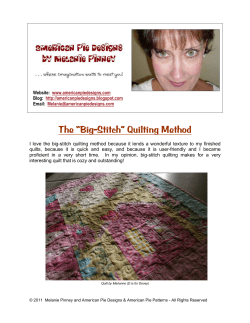
Mongolian Quilting Stitches
Mongolian Quilting Stitches A collection of stitches, patterns and a brief history. Mongolian Quilts? Well, no, but rugs, blankets, saddle pads, carrying bags and show soles – yes! In a culture that uses felt for the variety of purposes the Mongols do, you find ways to strengthen and enhance the felt. You, quite literally, weave it into your very existence. In this case the quilting of felt serves several purposes. It isn’t just running a thread through fabric. Felt is part of the heart and soul of the Mongolian people and it interacted in almost every aspect of their lives. The primary direction of this topic is to introduce you to the various stitches and stitching patterns used by the Mongols. However, I can’t help but add in a few items of interest and amusement that go hand in hand with the stitching. It seems that sewing or quilting stitches are fairly similar no matter where they originate. There are some variants. I don’t se the French knot in the Mongolian collection but I also associate it with embroidery rather than quilting. There are running stitches and blanket stitches and herringbone designs, some of the patterns are quite elaborate and could, with an industrious needle worker using various colors, produce some beautiful patterns. Which, as is evident in the rugs in many Gers, just exactly what they did. What I find most interesting is the shamanic aspect of the quilting and felt work. For example, in the case of felt being quilted, the edges of the felt are frequently reinforced with a braided or woven rope called the ZEEG. On felt rugs this Zeeg marks the boundaries of portions of the ger. Those delineations also mark the border between the men’s and women’s side of the ger. Those same lines are part of an ‘organic’ clock used by the Mongols to tell time. Time is somewhat relative and thus the hours are actually two hours long and overlap each other. But it is the relationship of the shadow on the ger rugs and the roof poles that tells time for the residents. The various patterns used in Mongolian quilting vary somewhat from clan to clan. The preferred colors and items seem to be fairly consistent throughout the Central Asian areas inhabited by the Mongols. Dye seems not to have been an option in most cases so the threads tended to be whatever color the animal was – thus lots of browns, grays, black and white. A prized rug would be very white with dark brown or black stitching. (No, I have no idea how they kept them clean.) Items of felt that are frequently quilted are Ger walls, door flaps, rugs or mats, saddle blankets, boots or shoes, hats, assorted bags and pouches and carrying containers. The majority of the patterns are geometric and repeat over large areas, however, you will also find more decorative work in the form of animals and plants. I wondered at the evenness of the layout but discovered that many villages apparently had a pattern maker who would assist in laying out and marking the patterns for the quilting. I’ve found no reference, so far, to such things as what we call Quilting Bees. The patterns would, quite 1 literally, be drawn on the felt with a fairly permanent ink made of Ochre powder and fresh dung. One of a young bride’s first projects was to create and stitch her own rugs for her future home. What follows is a collection of stitches and designs used in the felt quilting. The first view shows the actual various stitches and pattern formation. The following pictures are examples of various quilting patterns and design usage. It appears that the finished pieces all have zeeg’s. The zeegs are braided or plaited strand of threads made of horse, camel or yak hair which has been spun into threads then gathered in multiple strands for strength. In one reference it was mentioned that the threads were spun directly from the yak. I’m afraid I’ll have to check that out a bit more closely before I can suggest you sit by your yak and spin thread from it. 2 3 The object for today’s quilting exercise is a scissors case. In searching for things Mongolian I came across a pair of very modern looking shears that originated in China well before even Genghis Khan’s time. IF you prefer to make a needle case I have a photo of that also but Mongolian needle cases were hung on the wall of the ger – not, apparently, toted around on a chatelaine. Scissors case. In studying the homelier aspects of Mongolian culture I find that the edges between various societies are much more blurred than we’d like them to be. The many designs and patterns I’ve located are native, in one form or another in cultures that span the globe. Stirrups that have every appearance of being Celtic but are actually Mongolian. Muslims 4 in the Oirat clans who have blond hair and blue eyes. Simple tools such as spindles and cups appear very similar whether they be Mongolian, Celt or Ethiopian. Curious, isn’t it? A short bibliography; Felt Art of the Mongols by Luntengiin Batchuluun, Mongolian University of Arts and Culture, 2003. Printed in Ulaanbaatar, Mongolia Material Culture of Mongol Altai Region by Besud Ayushin Baasankhuu, Institute for Mongol Altai Studies, Ulaanbaatar, 2006. Sadly, neither book contains a bibliography of its own. Should you have questions or want to discuss this further, feel free to contact me. Chagan Khulan (Karen M. Summerfelt-Hume 3607 Young Road, Millers, MD 21102 443-789-9050 (NLT 9 PM) chagankhulan@comcast.net http://www.Freewebs.com/chagankhulan Copyright, May 26, 2007, Karen M. Summerfelt-Hume 5
© Copyright 2025





















